nnCostFunction.m
对于神经网络我们需要计算其损失函数值J(θ)与grad梯度。
1.前向传播计算损失函数值J(θ)
首先计算hθ(x)=a(3)
公式如下:

加入正则项的损失函数公式(注意程序中为向量表达,此处为数值表达):

2.反向传播计算梯度grad
公式中使用了g’(z(2)),故应先实现sigmod梯度值函数sigmoidGradient(z)。
之后按照公式计算:
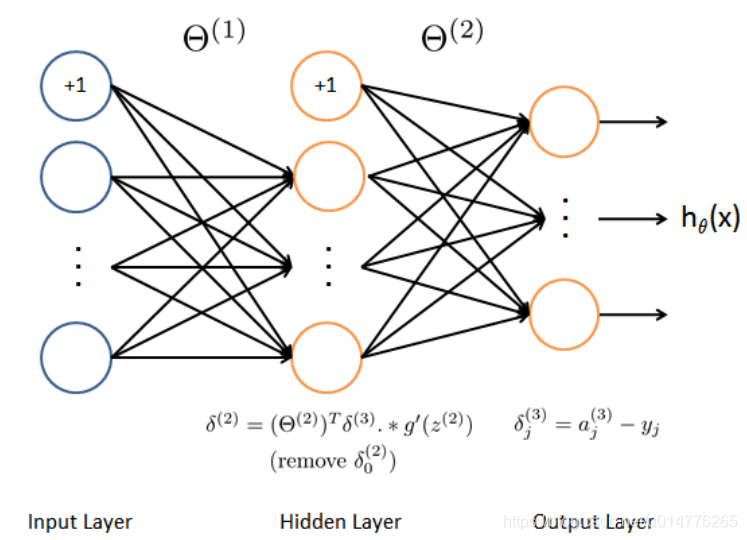
grad梯度计算:

function [J grad] = nnCostFunction(nn_params, ...
input_layer_size, ...
hidden_layer_size, ...
num_labels, ...
X, y, lambda)
%NNCOSTFUNCTION Implements the neural network cost function for a two layer
%neural network which performs classification
% [J grad] = NNCOSTFUNCTON(nn_params, hidden_layer_size, num_labels, ...
% X, y, lambda) computes the cost and gradient of the neural network. The
% parameters for the neural network are "unrolled" into the vector
% nn_params and need to be converted back into the weight matrices.
%
% The returned parameter grad should be a "unrolled" vector of the
% partial derivatives of the neural network.
%
% Reshape nn_params back into the parameters Theta1 and Theta2, the weight matrices
% for our 2 layer neural network
Theta1 = reshape(nn_params(1:hidden_layer_size * (input_layer_size + 1)), ...
hidden_layer_size, (input_layer_size + 1));
Theta2 = reshape(nn_params((1 + (hidden_layer_size * (input_layer_size + 1))):end), ...
num_labels, (hidden_layer_size + 1));
% Setup some useful variables
m = size(X, 1);
% You need to return the following variables correctly
J = 0;
Theta1_grad = zeros(size(Theta1));
Theta2_grad = zeros(size(Theta2));
% ====================== YOUR CODE HERE ======================
% Instructions: You should complete the code by working through the
% following parts.
%
% Part 1: Feedforward the neural network and return the cost in the
% variable J. After implementing Part 1, you can verify that your
% cost function computation is correct by verifying the cost
% computed in ex4.m
%
% Part 2: Implement the backpropagation algorithm to compute the gradients
% Theta1_grad and Theta2_grad. You should return the partial derivatives of
% the cost function with respect to Theta1 and Theta2 in Theta1_grad and
% Theta2_grad, respectively. After implementing Part 2, you can check
% that your implementation is correct by running checkNNGradients
%
% Note: The vector y passed into the function is a vector of labels
% containing values from 1..K. You need to map this vector into a
% binary vector of 1's and 0's to be used with the neural network
% cost function.
%
% Hint: We recommend implementing backpropagation using a for-loop
% over the training examples if you are implementing it for the
% first time.
%
% Part 3: Implement regularization with the cost function and gradients.
%
% Hint: You can implement this around the code for
% backpropagation. That is, you can compute the gradients for
% the regularization separately and then add them to Theta1_grad
% and Theta2_grad from Part 2.
%
temp = zeros(m,num_labels);
for j = 1:size(y,1)
temp(j,y(j)) = 1;
endfor
y = temp;
X = [ones(m,1) X];
%前向传播计算J
a2 = sigmoid(X * Theta1');
a3 = sigmoid([ones(size(a2,1),1) a2] * Theta2');
J = 1/m * sum(sum((-y).*log(a3) - (1-y).*log(1-a3)))+ lambda/(2*m)*...
(sum(sum(Theta1(:,2:input_layer_size+1).^2)) + sum(sum(Theta2(:,2:hidden_layer_size+1).^2)));
%反向传播计算grad
Error_3 = a3 - y;
sigmoidgrad1 = sigmoidGradient(X * Theta1');
Error_2 = Error_3 * Theta2 .* [ones(size(sigmoidgrad1,1),1) sigmoidgrad1];
Theta1_grad =1/m * Error_2(:,2:end)' * X + lambda/m * [zeros(size(Theta1,1),1) Theta1(:,2:end)];
Theta2_grad =1/m * Error_3' * [ones(size(a2,1),1) a2] + lambda/m * [zeros(size(Theta2,1),1) Theta2(:,2:end)];
% -------------------------------------------------------------
% =========================================================================
% Unroll gradients
grad = [Theta1_grad(:) ; Theta2_grad(:)];
end
运行结果
前向传播损失值J:

前向传播加入正则化的损失值J:

后向传播计算grad梯度与梯度检查:
左边是自己计算的数值梯度,右边是分析梯度(梯度检查的)
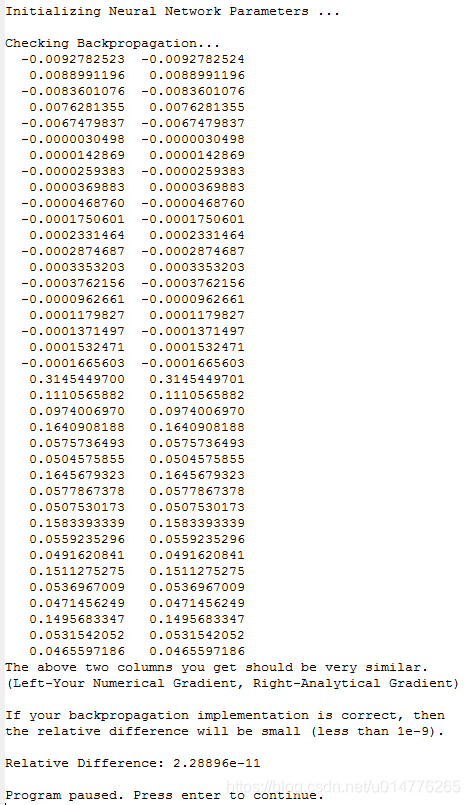
后向传播计算grad梯度与梯度检查加入正则化:
左边是自己计算的数值梯度,右边是分析梯度(梯度检查的)
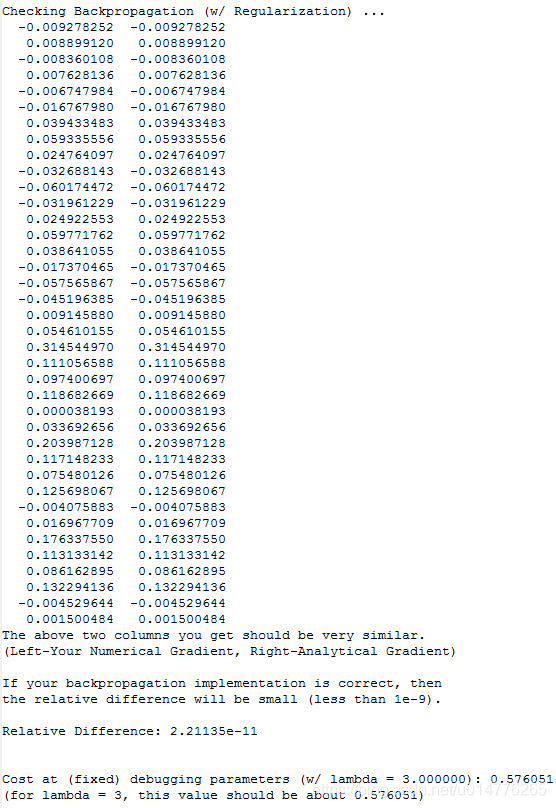
sigmod梯度值公式:
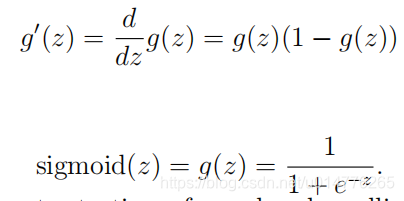
function g = sigmoidGradient(z)
%SIGMOIDGRADIENT returns the gradient of the sigmoid function
%evaluated at z
% g = SIGMOIDGRADIENT(z) computes the gradient of the sigmoid function
% evaluated at z. This should work regardless if z is a matrix or a
% vector. In particular, if z is a vector or matrix, you should return
% the gradient for each element.
g = zeros(size(z));
% ====================== YOUR CODE HERE ======================
% Instructions: Compute the gradient of the sigmoid function evaluated at
% each value of z (z can be a matrix, vector or scalar).
g = sigmoid(z).*(1-sigmoid(z));
% =============================================================
end
运行结果
sigmod的梯度

ex4.m
%% Machine Learning Online Class - Exercise 4 Neural Network Learning
% Instructions
% ------------
%
% This file contains code that helps you get started on the
% linear exercise. You will need to complete the following functions
% in this exericse:
%
% sigmoidGradient.m
% randInitializeWeights.m
% nnCostFunction.m
%
% For this exercise, you will not need to change any code in this file,
% or any other files other than those mentioned above.
%
%% Initialization
clear ; close all; clc
%% Setup the parameters you will use for this exercise
input_layer_size = 400; % 20x20 Input Images of Digits
hidden_layer_size = 25; % 25 hidden units
num_labels = 10; % 10 labels, from 1 to 10
% (note that we have mapped "0" to label 10)
%% =========== Part 1: Loading and Visualizing Data =============
% We start the exercise by first loading and visualizing the dataset.
% You will be working with a dataset that contains handwritten digits.
%
% Load Training Data
fprintf('Loading and Visualizing Data ...\n')
load('ex4data1.mat');
m = size(X, 1);
% Randomly select 100 data points to display
sel = randperm(size(X, 1));
sel = sel(1:100);
displayData(X(sel, :));
fprintf('Program paused. Press enter to continue.\n');
pause;
%% ================ Part 2: Loading Parameters ================
% In this part of the exercise, we load some pre-initialized
% neural network parameters.
fprintf('\nLoading Saved Neural Network Parameters ...\n')
% Load the weights into variables Theta1 and Theta2
load('ex4weights.mat');
% Unroll parameters
nn_params = [Theta1(:) ; Theta2(:)];
%% ================ Part 3: Compute Cost (Feedforward) ================
% To the neural network, you should first start by implementing the
% feedforward part of the neural network that returns the cost only. You
% should complete the code in nnCostFunction.m to return cost. After
% implementing the feedforward to compute the cost, you can verify that
% your implementation is correct by verifying that you get the same cost
% as us for the fixed debugging parameters.
%
% We suggest implementing the feedforward cost *without* regularization
% first so that it will be easier for you to debug. Later, in part 4, you
% will get to implement the regularized cost.
%
fprintf('\nFeedforward Using Neural Network ...\n')
% Weight regularization parameter (we set this to 0 here).
lambda = 0;
J = nnCostFunction(nn_params, input_layer_size, hidden_layer_size, ...
num_labels, X, y, lambda);
fprintf(['Cost at parameters (loaded from ex4weights): %f '...
'\n(this value should be about 0.287629)\n'], J);
fprintf('\nProgram paused. Press enter to continue.\n');
pause;
%% =============== Part 4: Implement Regularization ===============
% Once your cost function implementation is correct, you should now
% continue to implement the regularization with the cost.
%
fprintf('\nChecking Cost Function (w/ Regularization) ... \n')
% Weight regularization parameter (we set this to 1 here).
lambda = 1;
J = nnCostFunction(nn_params, input_layer_size, hidden_layer_size, ...
num_labels, X, y, lambda);
fprintf(['Cost at parameters (loaded from ex4weights): %f '...
'\n(this value should be about 0.383770)\n'], J);
fprintf('Program paused. Press enter to continue.\n');
pause;
%% ================ Part 5: Sigmoid Gradient ================
% Before you start implementing the neural network, you will first
% implement the gradient for the sigmoid function. You should complete the
% code in the sigmoidGradient.m file.
%
fprintf('\nEvaluating sigmoid gradient...\n')
g = sigmoidGradient([-1 -0.5 0 0.5 1]);
fprintf('Sigmoid gradient evaluated at [-1 -0.5 0 0.5 1]:\n ');
fprintf('%f ', g);
fprintf('\n\n');
fprintf('Program paused. Press enter to continue.\n');
pause;
%% ================ Part 6: Initializing Pameters ================
% In this part of the exercise, you will be starting to implment a two
% layer neural network that classifies digits. You will start by
% implementing a function to initialize the weights of the neural network
% (randInitializeWeights.m)
fprintf('\nInitializing Neural Network Parameters ...\n')
initial_Theta1 = randInitializeWeights(input_layer_size, hidden_layer_size);
initial_Theta2 = randInitializeWeights(hidden_layer_size, num_labels);
% Unroll parameters
initial_nn_params = [initial_Theta1(:) ; initial_Theta2(:)];
%% =============== Part 7: Implement Backpropagation ===============
% Once your cost matches up with ours, you should proceed to implement the
% backpropagation algorithm for the neural network. You should add to the
% code you've written in nnCostFunction.m to return the partial
% derivatives of the parameters.
%
fprintf('\nChecking Backpropagation... \n');
% Check gradients by running checkNNGradients
checkNNGradients;
fprintf('\nProgram paused. Press enter to continue.\n');
pause;
%% =============== Part 8: Implement Regularization ===============
% Once your backpropagation implementation is correct, you should now
% continue to implement the regularization with the cost and gradient.
%
fprintf('\nChecking Backpropagation (w/ Regularization) ... \n')
% Check gradients by running checkNNGradients
lambda = 3;
checkNNGradients(lambda);
% Also output the costFunction debugging values
debug_J = nnCostFunction(nn_params, input_layer_size, ...
hidden_layer_size, num_labels, X, y, lambda);
fprintf(['\n\nCost at (fixed) debugging parameters (w/ lambda = %f): %f ' ...
'\n(for lambda = 3, this value should be about 0.576051)\n\n'], lambda, debug_J);
fprintf('Program paused. Press enter to continue.\n');
pause;
%% =================== Part 8: Training NN ===================
% You have now implemented all the code necessary to train a neural
% network. To train your neural network, we will now use "fmincg", which
% is a function which works similarly to "fminunc". Recall that these
% advanced optimizers are able to train our cost functions efficiently as
% long as we provide them with the gradient computations.
%
fprintf('\nTraining Neural Network... \n')
% After you have completed the assignment, change the MaxIter to a larger
% value to see how more training helps.
options = optimset('MaxIter', 50);
% You should also try different values of lambda
lambda = 1;
% Create "short hand" for the cost function to be minimized
costFunction = @(p) nnCostFunction(p, ...
input_layer_size, ...
hidden_layer_size, ...
num_labels, X, y, lambda);
% Now, costFunction is a function that takes in only one argument (the
% neural network parameters)
[nn_params, cost] = fmincg(costFunction, initial_nn_params, options);
% Obtain Theta1 and Theta2 back from nn_params
Theta1 = reshape(nn_params(1:hidden_layer_size * (input_layer_size + 1)), ...
hidden_layer_size, (input_layer_size + 1));
Theta2 = reshape(nn_params((1 + (hidden_layer_size * (input_layer_size + 1))):end), ...
num_labels, (hidden_layer_size + 1));
fprintf('Program paused. Press enter to continue.\n');
pause;
%% ================= Part 9: Visualize Weights =================
% You can now "visualize" what the neural network is learning by
% displaying the hidden units to see what features they are capturing in
% the data.
fprintf('\nVisualizing Neural Network... \n')
displayData(Theta1(:, 2:end));
fprintf('\nProgram paused. Press enter to continue.\n');
pause;
%% ================= Part 10: Implement Predict =================
% After training the neural network, we would like to use it to predict
% the labels. You will now implement the "predict" function to use the
% neural network to predict the labels of the training set. This lets
% you compute the training set accuracy.
pred = predict(Theta1, Theta2, X);
fprintf('\nTraining Set Accuracy: %f\n', mean(double(pred == y)) * 100);
运行结果
数据集:
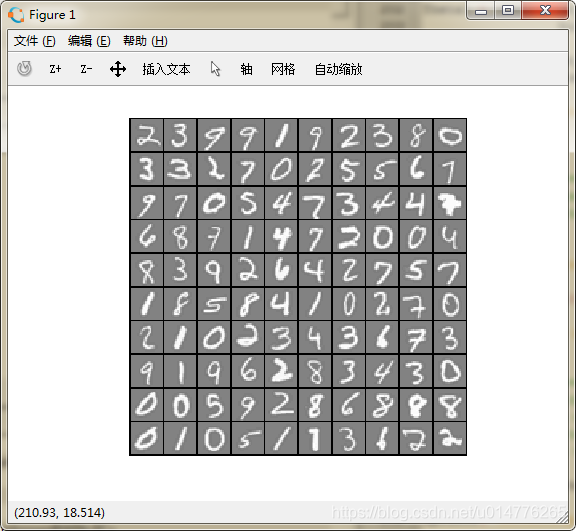
结果:
50轮迭代欠拟合,可以看到隐含层中的结果图都一样,且Training Set Accuracy(准确度)仅为31%
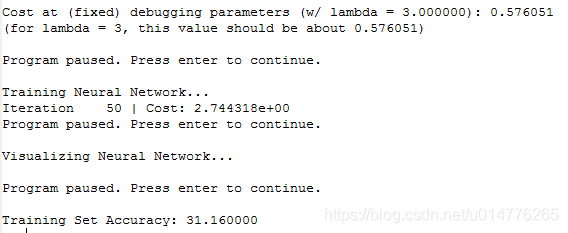
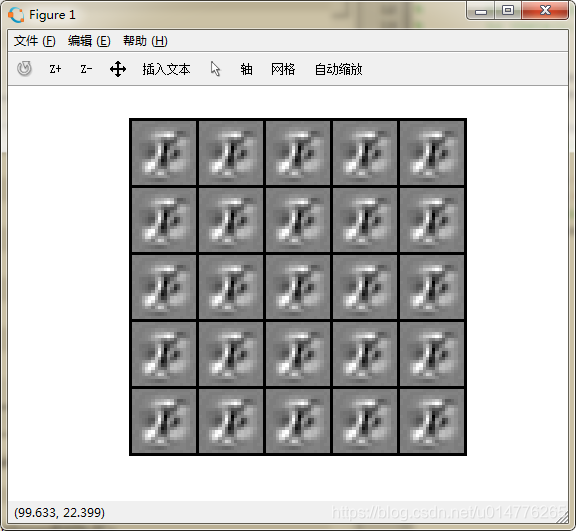
修改ex4.m中的MaxIter值
增加迭代轮数,可以看到每一轮迭代cost损失值都在减少,故为正确的。可以看到400轮迭代后,Training Set Accuracy(准确度)提高到89%.可以看到隐含层中的结果图不一样了。
options = optimset('MaxIter', 400);
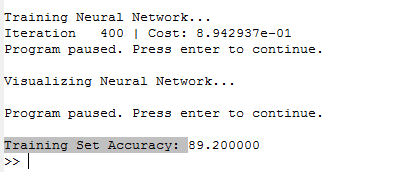
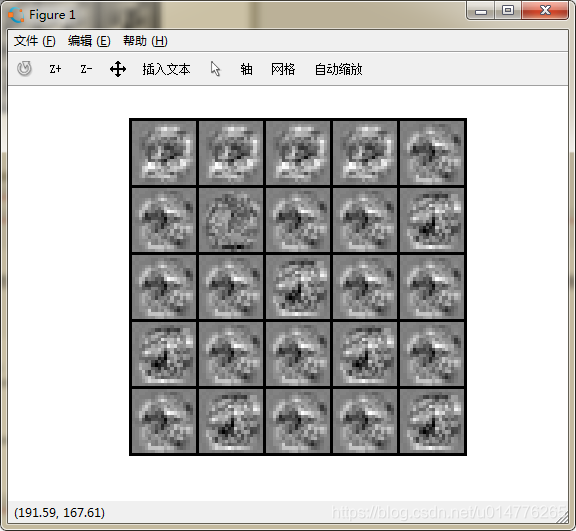







 本文详细解析了神经网络的成本函数计算及梯度计算方法,包括前向传播计算损失函数值、反向传播计算梯度,以及如何在计算过程中加入正则项。通过具体代码实现和运行结果展示,帮助读者深入理解神经网络训练过程。
本文详细解析了神经网络的成本函数计算及梯度计算方法,包括前向传播计算损失函数值、反向传播计算梯度,以及如何在计算过程中加入正则项。通过具体代码实现和运行结果展示,帮助读者深入理解神经网络训练过程。
















 974
974

 被折叠的 条评论
为什么被折叠?
被折叠的 条评论
为什么被折叠?








